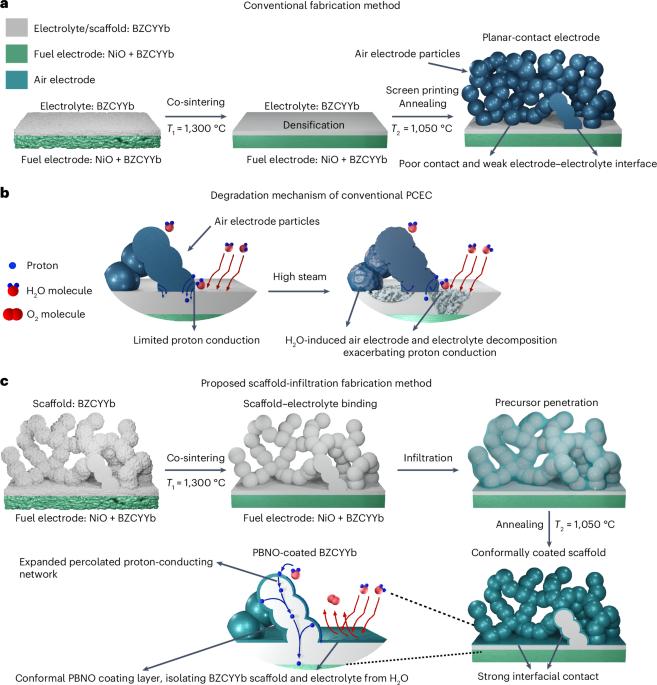保形涂层支架设计采用耐水Pr1.8Ba0.2NiO4.1,用于具有5000 -h电解稳定性的质子陶瓷电化学电池
IF 60.1
1区 材料科学
Q1 ENERGY & FUELS
引用次数: 0
摘要
质子陶瓷电化学电池(PCECs)具有作为长时间储能系统的潜力。然而,由于掺杂铈酸钡电解质和氧电极对H2O的固有化学不稳定性,以及电极-电解质界面接触不良,在工业相关条件下,它们的操作稳定性受到限制。在这里,我们提出了一种共形涂层支架(CCS)设计来全面解决这些问题。构建多孔质子导电支架,并包覆Pr1.8Ba0.2NiO4.1电催化剂,具有较高的抗水化学稳定性、三重导电性和水化能力,保护易受水损伤的电解质。CCS结构巩固了电极-电解质界面键合,使质子在渗透网络中快速转移。该设计使PCECs在- 1.5 A cm - 2和600°C的40% H2O条件下达到5000小时的电解稳定性。这项工作提供了稳定pcec的一般策略,并为设计弹性和稳定的固态储能系统提供了指导。本文章由计算机程序翻译,如有差异,请以英文原文为准。


Conformally coated scaffold design using water-tolerant Pr1.8Ba0.2NiO4.1 for protonic ceramic electrochemical cells with 5,000-h electrolysis stability
Protonic ceramic electrochemical cells (PCECs) have potential as long-duration energy storage systems. However, their operational stability is limited under industrially relevant conditions due to the intrinsic chemical instability of doped barium cerate-based electrolytes and oxygen electrodes against H2O, as well as the poor electrode–electrolyte interfacial contact. Here we present a conformally coated scaffold (CCS) design to comprehensively address these issues. A porous proton-conducting scaffold is constructed and conformally coated with Pr1.8Ba0.2NiO4.1 electrocatalyst, which has high chemical stability against H2O, triple conductivity and hydration capability, and protects vulnerable electrolytes from H2O. The CCS structure consolidates the electrode–electrolyte interfacial bonding to enable fast proton transfer in the percolated network. This design enables PCECs to reach electrolysis stability for 5,000 h at −1.5 A cm−2 and 600 °C in 40% H2O. This work provides a general strategy to stabilize PCECs and offers guidance for designing resilient and stable solid-state energy storage systems. Protonic ceramic electrochemical cells (PCECs) interconvert hydrogen and electricity and therefore have potential as long-duration energy storage systems, but the durability of these devices under industrially relevant conditions is limited. Here the authors report a PCEC that maintains low degradation rates throughout exceptionally long-term durability tests.
求助全文
通过发布文献求助,成功后即可免费获取论文全文。
去求助
来源期刊

Nature Energy
Energy-Energy Engineering and Power Technology
CiteScore
75.10
自引率
1.10%
发文量
193
期刊介绍:
Nature Energy is a monthly, online-only journal committed to showcasing the most impactful research on energy, covering everything from its generation and distribution to the societal implications of energy technologies and policies.
With a focus on exploring all facets of the ongoing energy discourse, Nature Energy delves into topics such as energy generation, storage, distribution, management, and the societal impacts of energy technologies and policies. Emphasizing studies that push the boundaries of knowledge and contribute to the development of next-generation solutions, the journal serves as a platform for the exchange of ideas among stakeholders at the forefront of the energy sector.
Maintaining the hallmark standards of the Nature brand, Nature Energy boasts a dedicated team of professional editors, a rigorous peer-review process, meticulous copy-editing and production, rapid publication times, and editorial independence.
In addition to original research articles, Nature Energy also publishes a range of content types, including Comments, Perspectives, Reviews, News & Views, Features, and Correspondence, covering a diverse array of disciplines relevant to the field of energy.
 求助内容:
求助内容: 应助结果提醒方式:
应助结果提醒方式:


